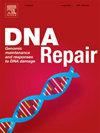Single-molecule toxicogenomics: Optical genome mapping of DNA-damage in nanochannel arrays
IF 2.7
3区 生物学
Q2 GENETICS & HEREDITY
引用次数: 0
Abstract
Quantitative genomic mapping of DNA damage may provide insights into the underlying mechanisms of damage and repair. Sequencing based approaches are bound to the limitations of PCR amplification bias and read length which hamper both the accurate quantitation of damage events and the ability to map them to structurally complex genomic regions. Optical Genome mapping in arrays of parallel nanochannels allows physical extension and genetic profiling of millions of long genomic DNA fragments, and has matured to clinical utility for characterization of complex structural aberrations in cancer genomes. Here we present a new mapping modality, Repair-Assisted Damage Detection - Optical Genome Mapping (RADD-OGM), a method for single-molecule level mapping of DNA damage on a genome-wide scale. Leveraging ultra-long reads to assemble the complex structure of a sarcoma cell-line genome, we mapped the genomic distribution of oxidative DNA damage, identifying regions more susceptible to DNA oxidation. We also investigated DNA repair by allowing cells to repair chemically induced DNA damage, pinpointing locations of concentrated repair activity, and highlighting variations in repair efficiency. Our results showcase the potential of the method for toxicogenomic studies, mapping the effect of DNA damaging agents such as drugs and radiation, as well as following specific DNA repair pathways by selective induction of DNA damage. The facile integration with optical genome mapping enables performing such analyses even in highly rearranged genomes such as those common in many cancers, a challenging task for sequencing-based approaches.
单分子毒物基因组学:纳米通道阵列中dna损伤的光学基因组图谱。
DNA损伤的定量基因组图谱可能为损伤和修复的潜在机制提供见解。基于测序的方法受到PCR扩增偏差和读取长度的限制,这既阻碍了损伤事件的准确定量,也阻碍了将它们映射到结构复杂的基因组区域的能力。在平行纳米通道阵列中的光学基因组图谱允许对数百万长的基因组DNA片段进行物理扩展和遗传分析,并且已经成熟到临床应用于癌症基因组中复杂结构畸变的表征。在这里,我们提出了一种新的作图方式,修复辅助损伤检测-光学基因组作图(rad - ogm),一种在全基因组范围内进行DNA损伤单分子水平作图的方法。利用超长读取来组装肉瘤细胞系基因组的复杂结构,我们绘制了氧化DNA损伤的基因组分布,确定了更容易受到DNA氧化的区域。我们还通过允许细胞修复化学诱导的DNA损伤,精确定位集中修复活性的位置,并突出修复效率的变化来研究DNA修复。我们的研究结果显示了该方法在毒性基因组学研究中的潜力,可以绘制DNA损伤剂(如药物和辐射)的影响,以及通过选择性诱导DNA损伤来遵循特定的DNA修复途径。光学基因组图谱的便捷整合,甚至可以对高度重排的基因组(如许多癌症中常见的基因组)进行这样的分析,这对于基于测序的方法来说是一项具有挑战性的任务。
本文章由计算机程序翻译,如有差异,请以英文原文为准。
求助全文
约1分钟内获得全文
求助全文
来源期刊

DNA Repair
生物-毒理学
CiteScore
7.60
自引率
5.30%
发文量
91
审稿时长
59 days
期刊介绍:
DNA Repair provides a forum for the comprehensive coverage of DNA repair and cellular responses to DNA damage. The journal publishes original observations on genetic, cellular, biochemical, structural and molecular aspects of DNA repair, mutagenesis, cell cycle regulation, apoptosis and other biological responses in cells exposed to genomic insult, as well as their relationship to human disease.
DNA Repair publishes full-length research articles, brief reports on research, and reviews. The journal welcomes articles describing databases, methods and new technologies supporting research on DNA repair and responses to DNA damage. Letters to the Editor, hot topics and classics in DNA repair, historical reflections, book reviews and meeting reports also will be considered for publication.
 求助内容:
求助内容: 应助结果提醒方式:
应助结果提醒方式:


